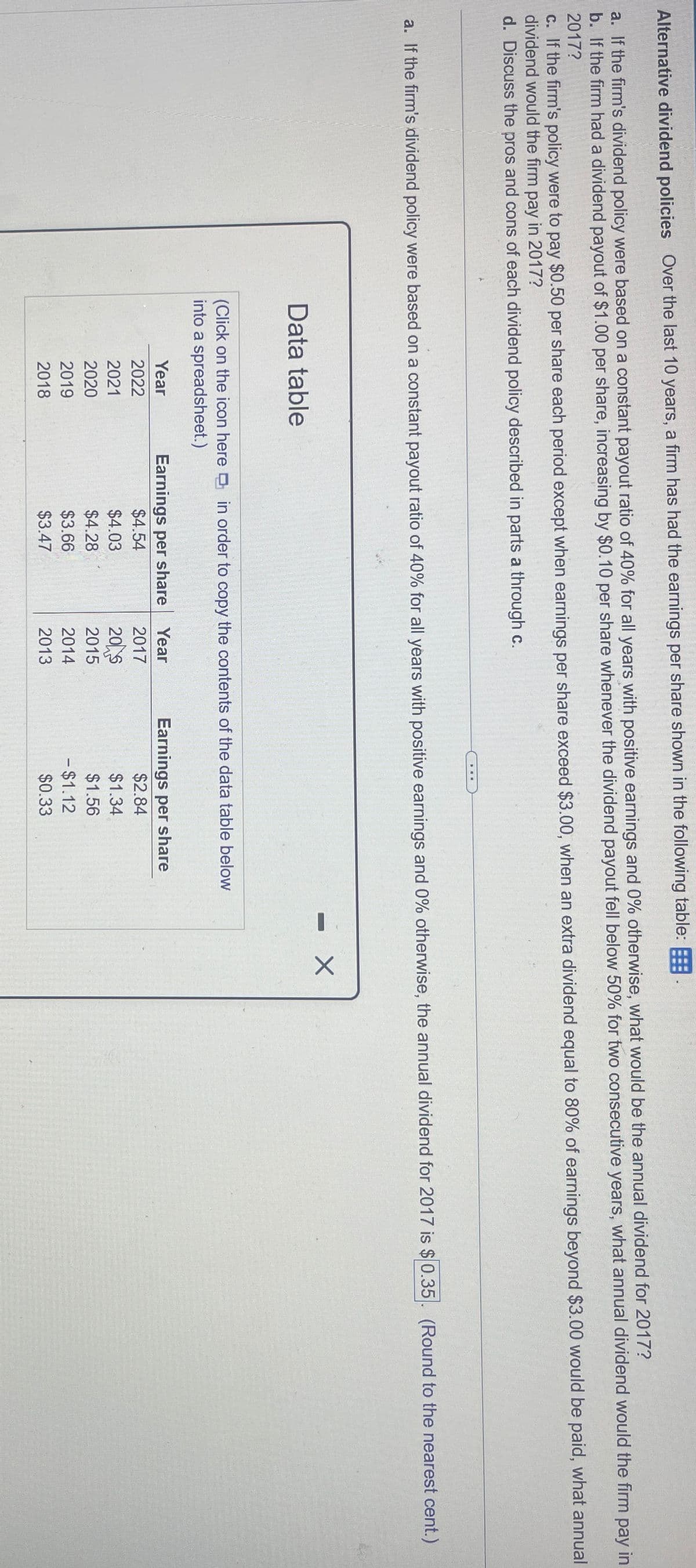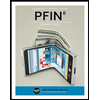Alternative dividend policies Over the last 10 years, a firm has had the earnings per share shown in the following table: a. If the firm's dividend policy were based on a constant payout ratio of 40% for all years with positive earnings and 0% otherwise, what would be the annual dividend for 2017? b. If the firm had a dividend payout of $1.00 per share, increasing by $0.10 per share whenever the dividend payout fell below 50% for two consecutive years, what annual dividend would the firm pay in 2017? c. If the firm's policy were to pay $0.50 per share each period except when earnings per share exceed $3.00, when an extra dividend equal to 80% of earnings beyond $3.00 would be paid, what annual dividend would the firm pay in 2017? d. Discuss the pros and cons of each dividend policy described in parts a through c. a. If the firm's dividend policy were based on a constant payout ratio of 40% for all years with positive earnings and 0% otherwise, the annual dividend for 2017 is $0.35 (Round to the nearest cent.) Data table (Click on the icon here in order to copy the contents of the data table below into a spreadsheet.) Year 2022 Earnings per share $4.54 Year Earnings per share 2017 $2.84 2021 $4.03 20 S $1.34 2020 $4.28 2015 $1.56 2019 $3.66 2014 -$1.12 2018 $3.47 2013 $0.33 -
Alternative dividend policies Over the last 10 years, a firm has had the earnings per share shown in the following table: a. If the firm's dividend policy were based on a constant payout ratio of 40% for all years with positive earnings and 0% otherwise, what would be the annual dividend for 2017? b. If the firm had a dividend payout of $1.00 per share, increasing by $0.10 per share whenever the dividend payout fell below 50% for two consecutive years, what annual dividend would the firm pay in 2017? c. If the firm's policy were to pay $0.50 per share each period except when earnings per share exceed $3.00, when an extra dividend equal to 80% of earnings beyond $3.00 would be paid, what annual dividend would the firm pay in 2017? d. Discuss the pros and cons of each dividend policy described in parts a through c. a. If the firm's dividend policy were based on a constant payout ratio of 40% for all years with positive earnings and 0% otherwise, the annual dividend for 2017 is $0.35 (Round to the nearest cent.) Data table (Click on the icon here in order to copy the contents of the data table below into a spreadsheet.) Year 2022 Earnings per share $4.54 Year Earnings per share 2017 $2.84 2021 $4.03 20 S $1.34 2020 $4.28 2015 $1.56 2019 $3.66 2014 -$1.12 2018 $3.47 2013 $0.33 -
Chapter15: Dividend Policy
Section: Chapter Questions
Problem 15P
Related questions
Question

Transcribed Image Text:Alternative dividend policies Over the last 10 years, a firm has had the earnings per share shown in the following table:
a. If the firm's dividend policy were based on a constant payout ratio of 40% for all years with positive earnings and 0% otherwise, what would be the annual dividend for 2017?
b. If the firm had a dividend payout of $1.00 per share, increasing by $0.10 per share whenever the dividend payout fell below 50% for two consecutive years, what annual dividend would the firm pay in
2017?
c. If the firm's policy were to pay $0.50 per share each period except when earnings per share exceed $3.00, when an extra dividend equal to 80% of earnings beyond $3.00 would be paid, what annual
dividend would the firm pay in 2017?
d. Discuss the pros and cons of each dividend policy described in parts a through c.
a. If the firm's dividend policy were based on a constant payout ratio of 40% for all years with positive earnings and 0% otherwise, the annual dividend for 2017 is $0.35
(Round to the nearest cent.)
Data table
(Click on the icon here in order to copy the contents of the data table below
into a spreadsheet.)
Year
2022
Earnings per share
$4.54
Year
Earnings per share
2017
$2.84
2021
$4.03
20 S
$1.34
2020
$4.28
2015
$1.56
2019
$3.66
2014
-$1.12
2018
$3.47
2013
$0.33
-
Expert Solution
This question has been solved!
Explore an expertly crafted, step-by-step solution for a thorough understanding of key concepts.
Step by step
Solved in 2 steps

Recommended textbooks for you

EBK CONTEMPORARY FINANCIAL MANAGEMENT
Finance
ISBN:
9781337514835
Author:
MOYER
Publisher:
CENGAGE LEARNING - CONSIGNMENT

Fundamentals Of Financial Management, Concise Edi…
Finance
ISBN:
9781337902571
Author:
Eugene F. Brigham, Joel F. Houston
Publisher:
Cengage Learning


EBK CONTEMPORARY FINANCIAL MANAGEMENT
Finance
ISBN:
9781337514835
Author:
MOYER
Publisher:
CENGAGE LEARNING - CONSIGNMENT

Fundamentals Of Financial Management, Concise Edi…
Finance
ISBN:
9781337902571
Author:
Eugene F. Brigham, Joel F. Houston
Publisher:
Cengage Learning


Pfin (with Mindtap, 1 Term Printed Access Card) (…
Finance
ISBN:
9780357033609
Author:
Randall Billingsley, Lawrence J. Gitman, Michael D. Joehnk
Publisher:
Cengage Learning

Managerial Accounting
Accounting
ISBN:
9781337912020
Author:
Carl Warren, Ph.d. Cma William B. Tayler
Publisher:
South-Western College Pub

PFIN (with PFIN Online, 1 term (6 months) Printed…
Finance
ISBN:
9781337117005
Author:
Randall Billingsley, Lawrence J. Gitman, Michael D. Joehnk
Publisher:
Cengage Learning